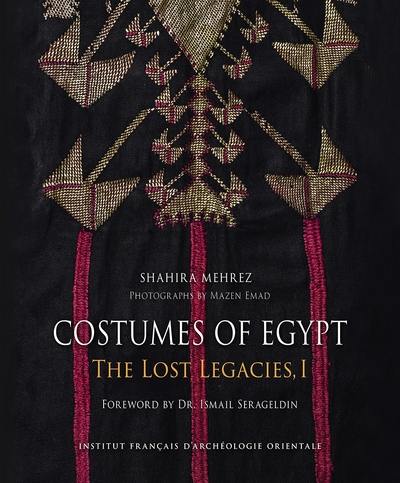
Serie : Costumes of Egypt : the lost legacies. Vol 1
Collection(s) : Bibliothèque générale
Paru le 21/11/2023 | Relié XVII-382 pages
Professionnels
photographs by Mazen Emad | foreword by Dr Ismail Serageldin
D'abord professeur d'art et d'architecture islamiques, Shahira Mehrez a consacré beaucoup de temps, à la fin des années 1970, à parcourir l'Égypte, à documenter l'architecture vernaculaire et à collecter des objets d'artisanat traditionnel. Ses collections de costumes et de bijoux, de tissages plats, de poteries et de vanneries sont les plus complètes du pays. Ancien membre du conseil d'administration du musée d'art islamique du Caire, elle se préoccupe également de la préservation du patrimoine architectural et a joué un rôle actif au sein de la Fondation pour le sauvetage du patrimoine égyptien. Au cours des cinquante dernières années, elle a donné des conférences, dans son pays et à l'étranger, afin de sensibiliser le public au patrimoine égyptien en péril. Costumes of Egypt : The Lost Legacies résume des décennies de recherche : il s'agit d'un ouvrage en quatre volumes qui recense et retrace l'origine de modes vestimentaires et de bijoux égyptiens jusqu'ici non documentés, dont la plupart sont aujourd'hui tombés en désuétude. Les costumes étudiés dans ce premier volume établissent qu'au-delà des situations géographiques éloignées, au-delà des diversités religieuses et ethniques, à travers des milliers d'années d'histoire et de civilisations successives, Nubiens, paysans de la Vallée du Nil, bédouins et habitants des oasis, à la fois chrétiens et musulmans, ont été les héritiers d'un même patrimoine. Anciens et nouveaux emblèmes se sont fondus dans une même tradition, définissant une identité égyptienne multiforme mais harmonieuse.
Shahira Mehrez, initially a teacher of Islamic art and architecture, by the late 1970s devoted herself to traveling throughout Egypt, documenting vernacular architecture and collecting traditional crafts. Her collections of costumes and jewelry, flat weaves, pottery, and basketry are the most comprehensive in the country. Formerly a member of the Board of Trustees of the Museum of Islamic Art, she is also concerned with the preservation of architectural heritage and has been active with the Egyptian Heritage Rescue Foundation. For the past fifty years, she has been lecturing at home and abroad to increase awareness of Egypt's endangered heritage. Costumes of Egypt : The Lost Legacies, sums up decades of research : it is a four-volume work recording and tracing the origin of hitherto undocumented ways of dressing and jewelry of Egyptian women, most of which have today become obsolete.
The costumes surveyed in this first volume establish the fact that irrespective of distant geographic locations, beyond religious and ethnic diversity, and throughout thousands of years of history and successive civilizations, Nubians, Nile Valley peasants, Bedouins and oasis dwellers, both Christian and Muslim, were heirs to the same legacy. Old and new emblems were melted into one tradition, defining a multifaceted but harmonious Egyptian identity. This tradition provides undeniable and tangible proof of the unity of the country and bears witness to the fact that throughout history these various communities were the different parts of a multicultural and pluralistic nation.